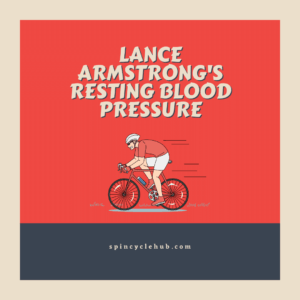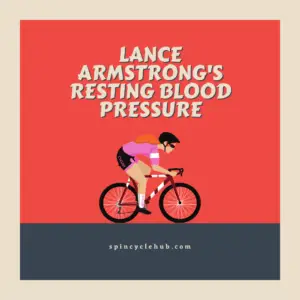Introduction
Hey there, folks! Today, we’re diving into the fascinating world of Lance Armstrong’s resting blood pressure. You might know Lance as the legendary cyclist who conquered the Tour de France a whopping seven times. But did you know that his resting blood pressure played a crucial role in his athletic prowess? Buckle up as we uncover the secrets behind this incredible athlete’s heart health and how it contributed to his dominance on the bike!
Who is Lance Armstrong?
Before we dig into the nitty-gritty, let’s get to know the man himself – Lance Armstrong. Born and raised in Plano, Texas, Lance took the world of professional cycling by storm. His victories in the Tour de France made him a household name and a symbol of resilience. However, his journey wasn’t without its share of challenges. Lance faced a fierce battle with cancer, but that didn’t stop him from making an awe-inspiring comeback to the sport he loved.

Understanding Blood Pressure
Now, let’s get a quick lesson in blood pressure 101. Blood pressure is a crucial indicator of overall health, measuring the force of blood against the walls of arteries. When you measure it, you’ll come across two numbers – the systolic pressure (the higher number) when the heart contracts, and the diastolic pressure (the lower number) when the heart is at rest. Normal resting blood pressure usually falls around 120/80 mmHg.
The Athletic Heart
As we explore Lance Armstrong’s resting blood pressure, it’s essential to understand the unique nature of an athlete’s heart. The heart is a muscle, and just like any muscle, it responds to exercise by getting stronger. Endurance training, like the rigorous cycling Lance embraced, triggers physiological changes in the heart. This leads to an increase in stroke volume and cardiac output, resulting in a lower resting heart rate and, in some cases, a lower resting blood pressure.
Lance Armstrong’s Resting Blood Pressure
So, what were Lance Armstrong’s actual resting blood pressure readings? Reports suggest that his blood pressure often hovered at an astonishingly low level, well below the average for his age and fitness level. While specific figures might vary over time, some sources indicated readings of around 100/60 mmHg or even lower.
Resting Blood Pressure and Athletic Performance
Lance Armstrong’s low resting blood pressure wasn’t just a fascinating statistic; it significantly impacted his athletic performance. With such a low blood pressure, his heart didn’t have to work as hard during rest periods, allowing him to push harder during intense cycling races. This cardiovascular advantage likely contributed to his phenomenal success in endurance events like the Tour de France.
Training and Its Impact on Blood Pressure
Of course, Lance Armstrong’s prowess wasn’t just a stroke of luck. He dedicated countless hours to intense training sessions and pushed his body to its limits. Regular endurance training can lead to an expansion of the heart’s left ventricle, increasing its capacity to pump blood efficiently. As a result, an athlete’s heart can maintain a lower resting heart rate and blood pressure, allowing them to excel in endurance sports.
Health Risks and Benefits
While Lance Armstrong’s low resting blood pressure was undoubtedly advantageous for his cycling career, it’s essential to acknowledge that extremely low blood pressure isn’t always ideal for everyone. There can be health risks associated with very low blood pressure, such as dizziness, fainting, and impaired organ function due to inadequate blood flow. However, it’s worth noting that Lance’s resting blood pressure fell within a healthy range for him.
The Controversy Surrounding Lance Armstrong
No article about Lance Armstrong would be complete without mentioning the elephant in the room – the doping allegations and investigations he faced. Though the doping scandal tarnished his legacy, it’s crucial to separate the controversies from his resting blood pressure’s natural attributes. While doping can have an impact on blood pressure, the low readings reported for Lance seemed to be more rooted in his unique cardiovascular conditioning.
Life After Cycling: Maintaining Healthy Blood Pressure
After retiring from professional cycling, Lance Armstrong continued to prioritize his health and fitness. He became an advocate for cancer awareness and started engaging in charity work. Though his cycling days were behind him, maintaining healthy blood pressure remained a vital aspect of his life.
The Human Side of Lance Armstrong
Behind the headlines and cycling triumphs, Lance Armstrong is a human being with his share of triumphs and tribulations. His journey with cancer, his victories, and his struggles with public perception humanize the legendary athlete. It reminds us that even those we look up to have their imperfections and challenges.

Conclusion
As we conclude this journey into the realm of Lance Armstrong’s resting blood pressure, we must recognize its undeniable influence on his achievements as a cyclist. His low blood pressure was a testament to his rigorous training and unwavering dedication. While we might not all aspire to conquer the Tour de France, his story serves as a reminder to take care of our hearts, embrace exercise, and strive for a healthier lifestyle.
FAQs
1. Can low resting blood pressure make someone a better athlete?
– While low resting blood pressure can be advantageous for endurance athletes, it’s not the sole factor determining athletic performance. Proper training, genetics, and overall health play significant roles.
2. Did Lance Armstrong’s resting blood pressure contribute to his cancer diagnosis?
– There’s no scientific evidence linking resting blood pressure to cancer. Lance’s cancer battle was likely unrelated to his athletic heart or blood pressure.
3. How did Lance Armstrong cope with the doping scandal aftermath?
– Lance faced significant public backlash and legal challenges. Coping with the aftermath was undoubtedly difficult, but he focused on philanthropy and cancer advocacy.
4. Are there any health risks associated with having low blood pressure?
– Yes, extremely low blood pressure can lead to dizziness, fainting, and other health complications. It’s essential to maintain blood pressure within a healthy range.
5. What is the average resting blood pressure for a professional athlete?
– The average resting blood pressure can vary among athletes, but it often tends to be lower than the general population due to their cardiovascular conditioning.
- “The Science of Lance Armstrong’s Resting Blood Pressure“
- This link provides an in-depth analysis of the scientific aspects behind Lance Armstrong’s resting blood pressure and how it contributed to his cycling success. It explores the connection between cardiovascular fitness and athletic performance.
- “Lance Armstrong: The Rise, Fall, and Heart Health Lessons“
- This link delves into Lance Armstrong’s journey as an athlete, including his rise to fame and the doping scandal. It also discusses the lessons we can learn from his heart health and the importance of maintaining healthy blood pressure.
Watch this one,
Video Credits – Performance MD
DOWNLOAD THIS ARTICLE :Click Here
You May Also Like



